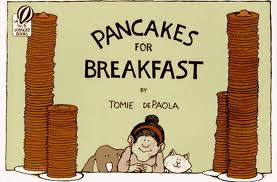
DePaola, T. (1978). Pancakes for Breakfast. San Diego, CA: Harcourt.
Brief Annotation: Waking up one morning, “Lydia” was very hungry for pancakes. She begins gathering the necessary supplies. Although it takes her a long time to collect all the ingredients, she never gives up, knowing it will be worth all her efforts. After collecting maple syrup from a neighbor’s house, she returns home to discover that her dog and cat have gobbled up all her ingredients! Her breakfast is ruined! She starts to feel sad, but soon notices a delicious smell coming from next door. Her neighbors are fixing pancakes for breakfast! She joins them and returns home happy and content.
Genre: Fantasy, Wordless picturebook
Grade Level: Pre K- 2
Readers who will like this: Children with lively imaginations, children who are developing storytelling abilities, children who would benefit from a good role model who keeps trying and never gives up
Response/Rating (1-4): 4, I loved this simple story, so much so that I named the main character, “Lydia” as she reminded me of my grandmother. Children will love the illustrations and practicing their storytelling skills during a “reading” of this enchanting book. They have the opportunity to name all the characters within the story, which is a great way to identify with the storyline and make it their own! The book’s positive message about the power of determination will provide great classroom discussion.
One question you would ask before a read aloud: What do you do if something does not go right the first time?
Reading Strategies Connection: Graphic Organizers-Story Maps (Yopp and Yopp, p. 73-75). In order for children to make the connection between story elements involved in problem solving, it would be helpful to make a type of graphic organizer, in this case, a story map. The map contains columns for the setting, characters, problems, events, and solutions. This activity begins during the “reading” as elements are discovered and then written down. Following the conclusion of the story, classroom discussions allow children to begin to understand the “big picture” or the main theme of the story, in this case, to keep trying and never give up. It is also a great way for children to learn the source of ingredients, such as eggs and milk.
No comments:
Post a Comment